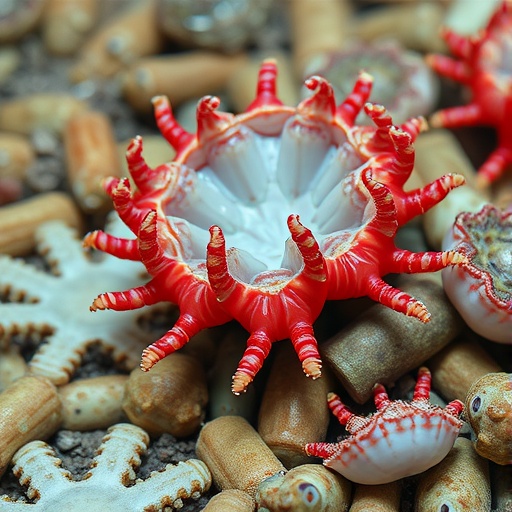In a groundbreaking study published in Environmental Earth Sciences, researchers have unveiled critical insights into the bioaccumulation of potentially toxic elements (PTEs) in marine ecosystems along the Red Sea coast. By focusing on two barnacle species, Perforatus perforatus and Tetraclita squamosa, the research explores how these sessile organisms interact with their surrounding environments, particularly through the sediments they inhabit. This innovative investigation sheds light on the complex dynamics of marine pollution and raises urgent questions about the ecological risks posed by harmful elements permeating coastal waters.
The Red Sea, an iconic marine environment known for its rich biodiversity and unique hydrological characteristics, faces increasing anthropogenic pressures. Coastal development, industrial activity, and shipping correlate with elevated levels of heavy metals and other toxic elements, which threaten the health of marine life and, by extension, human populations relying on these resources. This study’s approach—assessing both barnacle species and their associated sediments—provides an integrative perspective on how toxic elements migrate and accumulate in coastal habitats.
Barnacles, being filter-feeders and sessile crustaceans, serve as excellent bioindicators for monitoring environmental contamination. Their capacity to bioaccumulate toxic substances in their tissues offers a window into the quality of their immediate surroundings. By measuring PTE concentrations in both P. perforatus and T. squamosa, the researchers aimed to decipher species-specific accumulation patterns and evaluate the potential health risks posed by these elements. The dual-species methodology also enriches comparative analyses within benthic communities.
Sampling was conducted across multiple sites along the Red Sea coast to capture spatial variability in PTE concentrations. Sediment samples from these locations provided baseline data on the environmental reservoir of toxic substances. The study meticulously quantified concentrations of key metals and metalloids, including but not limited to arsenic (As), cadmium (Cd), lead (Pb), and mercury (Hg). These elements are well documented for their deleterious effects on marine organisms and food webs.
A central revelation from the study highlights that both barnacle species displayed significant bioaccumulation of these toxic elements, yet with distinct species-specific patterns. Tetraclita squamosa, for instance, exhibited higher concentrations of Cd and Pb relative to Perforatus perforatus, suggesting differential physiological or ecological mechanisms influencing uptake and retention. Such variations likely reflect differences in feeding behavior, habitat preference, and biochemical pathways responsible for metal binding and detoxification.
The sediment analyses reinforced the barnacle tissue data, revealing hotspots of contamination in proximity to human settlements and industrial zones. Sediments act as both sinks and secondary sources of PTEs, from which marine organisms can accumulate toxins either directly or through trophic transfer. The researchers emphasized the role of sediment composition and grain size, known to affect metal adsorption capacity and bioavailability, as crucial factors modulating contaminant bioaccumulation.
Importantly, this study advances the understanding of environmental stressors in the Red Sea, especially in the context of global climate change and increasing anthropogenic load. Toxic element bioaccumulation in benthic invertebrates like barnacles could have cascading impacts on marine food webs, given that these organisms serve as prey for higher trophic levels. The potential biomagnification of these PTEs through the food chain raises concerns about ecological balance and human health risks associated with seafood consumption.
Methodologically, the research employed rigorous sampling protocols and state-of-the-art analytical techniques such as inductively coupled plasma mass spectrometry (ICP-MS), enabling high sensitivity and precision in measuring trace element concentrations. This technical rigor ensures robust reliability of the dataset, paving the way for longitudinal monitoring programs and targeted remediation strategies.
Beyond ecological implications, the findings underscore the utility of barnacles as sentinel species for environmental monitoring in coastal zones. Unlike mobile species that might migrate away from polluted areas, barnacles’ stationary lifestyle offers localized contamination insights, making them invaluable indicators to trace spatial heterogeneities in pollution patterns.
The study also contributes to foundational ecological toxicology literature by illustrating how bioaccumulation dynamics differ among closely related species. Such knowledge is vital for environmental risk assessments and for developing species-specific mitigation approaches. Conservationists and policymakers can utilize these insights to prioritize areas requiring urgent intervention and to formulate guidelines regulating pollutant discharge.
Moreover, the research carries significant socio-economic ramifications for communities dependent on Red Sea resources. Pollutants accumulated in marine organisms ultimately impact fisheries sustainability and public health, highlighting the intricate link between environmental integrity and human welfare. This study thus advocates for integrated coastal zone management policies combining scientific evidence with socio-political action.
While the investigation focuses on two barnacle species, it opens avenues for broader multidisciplinary research encompassing other benthic and pelagic organisms. Comparative studies could further elucidate trophic transfer mechanisms and cumulative exposure effects across multiple species, enhancing ecosystem-wide understanding of PTE dynamics.
Concluding, the detailed examination of bioaccumulation of potentially toxic elements in Perforatus perforatus and Tetraclita squamosa, alongside sediment contamination profiles, provides a vital analytical framework for ongoing environmental surveillance. The study not only highlights the urgent need to address coastal pollution but also exemplifies how marine invertebrates function as living archives of environmental health, reflecting both local and systemic ecological disturbances.
As maritime activities and coastal urbanization intensify globally, such insightful scientific endeavors become critical in safeguarding the delicate balance of marine ecosystems. The Red Sea, renowned for its biodiversity, stands as a sentinel region where the interplay between environmental stressors and biological responses can offer lessons applicable worldwide, urging collective stewardship for sustained ocean health.
Subject of Research: Bioaccumulation of potentially toxic elements in barnacle species and associated sediments along the Red Sea coast.
Article Title: Bioaccumulation of potentially toxic elements in two barnacle species (Perforatus perforatus and Tetraclita squamosa) and their associated sediments from the Red Sea coast.
Article References:
Aljahdali, M.H., Nour, H.E. Bioaccumulation of potentially toxic elements in two barnacle species (Perforatus perforatus and Tetraclita squamosa) and their associated sediments from the Red Sea coast. Environ Earth Sci 84, 642 (2025). https://doi.org/10.1007/s12665-025-12612-7
Image Credits: AI Generated




